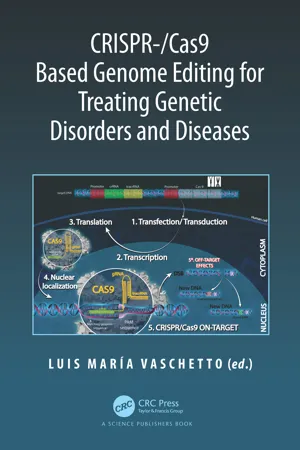
CRISPR-/Cas9 Based Genome Editing for Treating Genetic Disorders and Diseases
- 262 pages
- English
- ePUB (mobile friendly)
- Available on iOS & Android
CRISPR-/Cas9 Based Genome Editing for Treating Genetic Disorders and Diseases
About this book
The CRISPR-Cas9 genome-editing system is creating a revolution in the science world. In the laboratory, CRISPR-Cas9 can efficiently be used to target specific genes, correct mutations and regulate gene expression of a wide array of cells and organisms, including human cells. CRISPR-/Cas9 Based Genome Editing for Treating Genetic Disorders and Diseases is a unique reading material for college students, academicians, and other health professionals interested in learning about the broad range of applications of CRISPR/Cas9 genetic scissors. Some topics included in this book are: the role of the CRISPR/Cas9 system in neuroscience, gene therapy, epigenome editing, genome mapping, cancer, virus infection control strategies, regulatory challenges and bioethical considerations.
Frequently asked questions
- Essential is ideal for learners and professionals who enjoy exploring a wide range of subjects. Access the Essential Library with 800,000+ trusted titles and best-sellers across business, personal growth, and the humanities. Includes unlimited reading time and Standard Read Aloud voice.
- Complete: Perfect for advanced learners and researchers needing full, unrestricted access. Unlock 1.4M+ books across hundreds of subjects, including academic and specialized titles. The Complete Plan also includes advanced features like Premium Read Aloud and Research Assistant.
Please note we cannot support devices running on iOS 13 and Android 7 or earlier. Learn more about using the app.
Information
CHAPTER 1 The CRISPR/Cas9 Genome-editing System_ Principles and Applications
Introduction


The bacterial origin of CRISPR/Cas
The discovery of CRISPR/Cas nucleases system
Components of the CRISPR/Cas system
Table of contents
- Cover Page
- Title Page
- Copyright Page
- Preface
- Table of Contents
- 1. The CRISPR/Cas9 Genome-editing System: Principles and Applications
- 2. Recent Applications of CRISPR-Cas9 in Genome Mappingand Sequencing
- 3. Gene Editing and Genetic Disorders: Ethical and Legal Concerns
- 4. Political, Regulatory and Ethical Considerations of the CRISPR/CasGenome Editing Technology
- 5. CRISPR/Cas and Gene Therapy: An Overview
- 6. CRISPR and Cancer: From Bench to Clinic
- 7. The Advances of the CRISPR/Cas9 Technology for CorrectingGenetic Disorders: Using Sarcoma as a Model System
- 8. CRISPR/Cas9 Technology as a Strategy Against Viral Infections
- 9. CRISPR/Cas9-based Genome and Epigenome Editing inNeuroscience Research
- 10. Non-viral Alternatives to Delivery of CRISPR-Cas GeneEditing Components
- 11. CRISPR Medicine: Advance, Progress and Challenges
- Subject Index